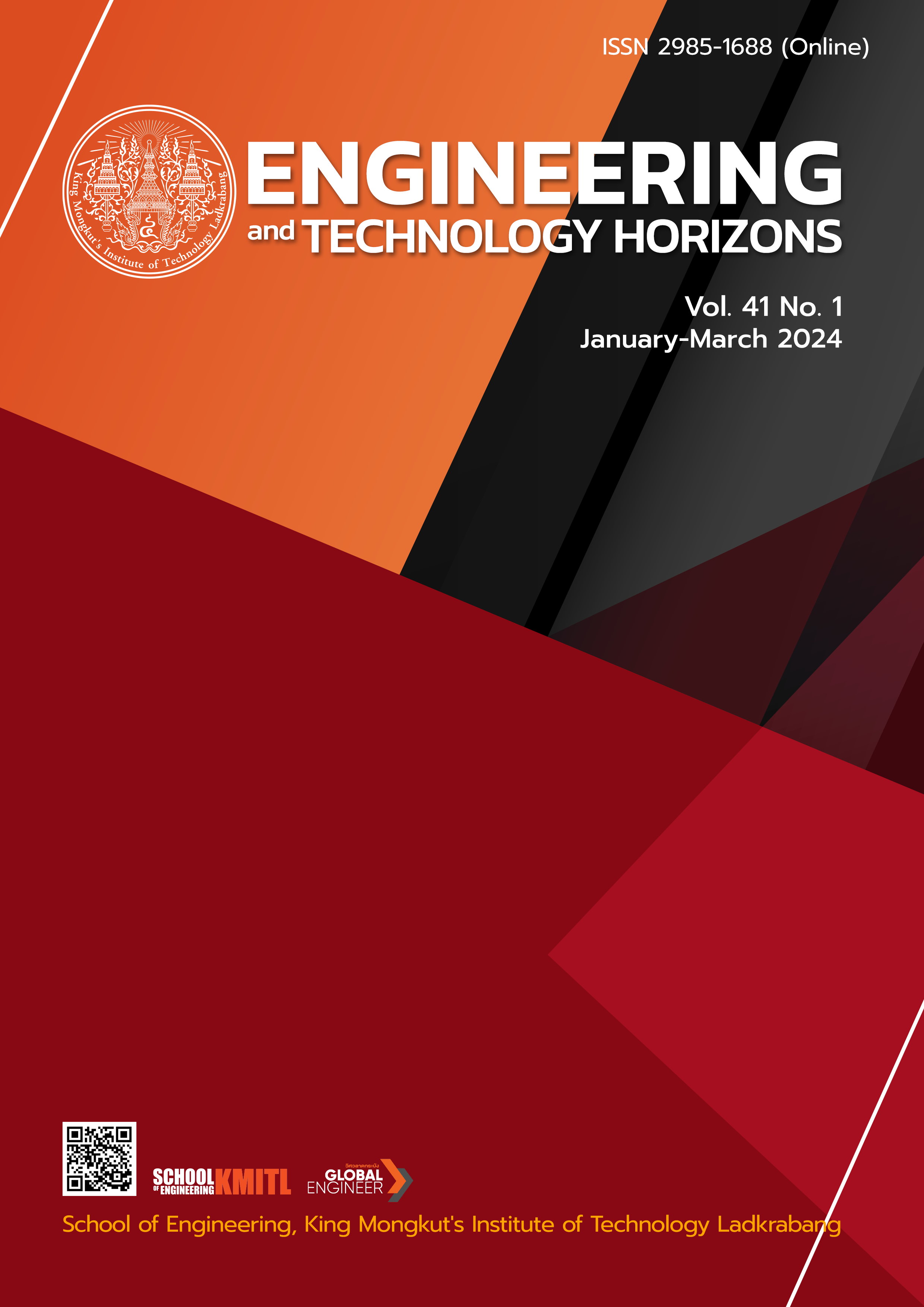Non-destructive Moisture Content Testing for Soil Brick Using Capacitive Measurement With 50 MHz Radio Frequency
DOI:
https://doi.org/10.55003/ETH.410104Keywords:
Dielectric Material, Radio Frequency, Moisture Content, Soil Brick, CapacitanceAbstract
This research paper presents a soil brick moisture measurement by capacitive measurement with radio frequency of 50 MHz and the soil brick as the dielectric material sandwiched between the conductive plates of the capacitor. The moisture content of the soil brick was considered from the capacitance storage capacity of the capacitor. The proposed measurement consisted of a voltage-controlled oscillator, capacitance measurement circuit, radio frequency amplifier, radio frequency detector, and microcontroller unit. After that, a circuit was built and assembled to the radio frequency soil moisture meter of soil bricks for evaluate the soil brick with width of 20 cm, length of 40 cm and the thickness of 20 cm. There are four types of soil brick with moisture of 10% to 30% and 10 times of iterations. From measured results, it was found that the dielectric constant and capacitive value are directed variation with moisture content of soil bricks. Therefore, the moisture content of soil bricks can be found by capacitive measurement. From the measured results, it accurate when comparing the standard measurement with an error of 4–16%.
References
J. Jandai, S. Sarakom and D. D. Shiraz, “Earth house philosophy and steps in building a clay house ,” in Earth house, easy way of people who want to have a home, 5th edition Bangkok, Thailand: Natural Agriculture, 2012, year, ch. 1, sec. 1, pp. 1–112.
D. Sinlapasai, “Earth house: an alternative architecture case study: Baan srithan, Aumphor Pateaw, Yasothon Province,” M. Arch., Dept. Architecture, Silpakorn Univ., Bangkok, Thailand, 2003.
P. Thaochalee, P. Potibut and S. Jumpadang, “Isan adobe house: Model and utilization,” Governance Journal, vol. 8, no. 1, pp. 252–264, 2019.
P. Boonsilp and S. Laoakka, “Earth-sheltered architecture: applying wisdom to build for living place in northeast Thailand,” NRRU Community Research Journal, vol. 14, no. 4, pp. 129–143, 2020.
P. Chuchaisong and S. Wongthong, “Study of the properties of clay bricks produced in Chon Buri Province,” B.E. project, Engineering Dept., Burapha Univ., Thailand, 2009.
W. Ratanathavorn, S. Junbuala and W. Ratanathavorn, “Research and development of circulating system of heat loss from clay brick kiln for raw clay brick drying,” Suan Dusit University, Bangkok, Thailand, Final rep., 2018.
A. Hola, “Measuring of the moisture content in brick walls of historical buildings – the overview of methods,” in IOP Conference Series: Materials Science and Engineering, Riga, Latvia, Sep. 17–29, 2017, pp. 1–8.
D. Giaccone, U. Santamaria and M. Corradi, “An experimental study on the effect of water on historic brickwork masonry,” Heritage, vol. 3, pp. 29–46, 2020.
M. Anuseri, “Testing properties and mechanical properties of bricks,” in Theory and practice of material testing in civil engineering, Bangkok, Thailand: Se-Ed Book Center Co., Ltd, 2011, ch. 4, sec. 1, pp. 111–134.
A. Robert, “Dielectric permittivity of concrete between 50 Mhz and 1 Ghz and GPR measurements for building materials evaluation,” Journal of Applied Geophysics, vol. 40, no. 1–3, pp. 89–94, 1998, doi: 10.1016/S0926-9851(98)00009-3.
Department of Internal Trade, “Formulation of moisture deduction standards for maize kernels for animal feed” opsmoac.go.th. https://www.opsmoac.go.th/news-preview-411991791165 (accessed May 2, 2019)
J. L. R. Pauco, I. G. B. Carandang, A. B. Cayabyab, C. G. P. Quiño and E. P. Enriquez, “Low-cost DIY capacitive sensor for water activity of food samples,” in 2023 IEEE International Conference on Agrosystem Engineering, Technology & Applications (AGRETA), Shah Alam, Malaysia, 2023, pp. 98–101, doi:10.1109/AGRETA57740.2023.10262650.
M. A. S. Tajin, W. M. Mongan and K. R. Dandekar, “Passive RFID-Based Diaper Moisture Sensor,” IEEE Sensors Journal, vol. 21, no. 2, pp. 1665–1674, 2021, doi: 10.1109/JSEN.2020.3021395.
N. Hosseini and M. Baghelani, “Selective real-time non-contact multivariable water-alcohol-sugar concentration analysis during fermentation process using microwave split-ring resonator based sensor,” Sensors and Actuators A: Physical, vol. 325, Jul. 2021, Art. no. 112695, doi: 10.1016/j.sna.2021.112695.
R. D. Lee, H. J. Kim and P. Y. Semenov, “Precise measurement of the dielectric constants of liquids using the principle of cross capacitance,” IEEE Transactions on Instrumentation and Measurement, vol. 50, no. 2, pp. 298–301, 2001, doi: 10.1109/19.918126.
C. Gilmore, M. Asefi, J. Paliwal, and J. LoVetri, “Industrial scale electromagnetic grain bin monitoring,” Computers and Electronics in Agriculture, vol. 136, pp. 210–220, 2017, doi: 10.1016/j.compag.2017.03.005.
B. L. Shrestha, H. C. Wood, L. Tabil, O. -D. Baik and S. Sokhansanj, “Microwave permittivity-assisted artificial neural networks for determining moisture content of chopped alfalfa forage,” IEEE Instrumentation & Measurement Magazine, vol. 20, no. 3, pp. 37–42, 2017, doi: 10.1109/MIM.2017.7951691.
L. Fan, Z. Chai, Y. Wang, Z. Wang, P. Zhao, J. Li, Q. Zhou, X. Qin, J. Yao, S. Yan, et. al., “A novel handheld device for intact corn ear moisture content measurement,” IEEE Transactions on Instrumentation and Measurement, vol. 69, no. 11, pp. 9157–9169, 2020, doi: 10.1109/TIM.2020.2994603
N. Javanbakht, G. Xiao and R. E. Amaya, “A comprehensive review of portable microwave sensors for grains and mineral materials moisture content monitoring,” IEEE Access, vol. 9, pp. 120176–120184, 2021, doi: 10.1109/ACCESS.2021.3108906.
R. Fiore, “Effective Capacitance VS Frequency,” in Circuit Designer’s Notebook, Fountain Inn, SC, USA: American Technical Ceramics, 2000, ch. 8, pp. 8.
Downloads
Published
How to Cite
Issue
Section
License
Copyright (c) 2024 School of Engineering, King Mongkut’s Institute of Technology Ladkrabang

This work is licensed under a Creative Commons Attribution-NonCommercial-NoDerivatives 4.0 International License.
The published articles are copyrighted by the School of Engineering, King Mongkut's Institute of Technology Ladkrabang.
The statements contained in each article in this academic journal are the personal opinions of each author and are not related to King Mongkut's Institute of Technology Ladkrabang and other faculty members in the institute.
Responsibility for all elements of each article belongs to each author; If there are any mistakes, each author is solely responsible for his own articles.






